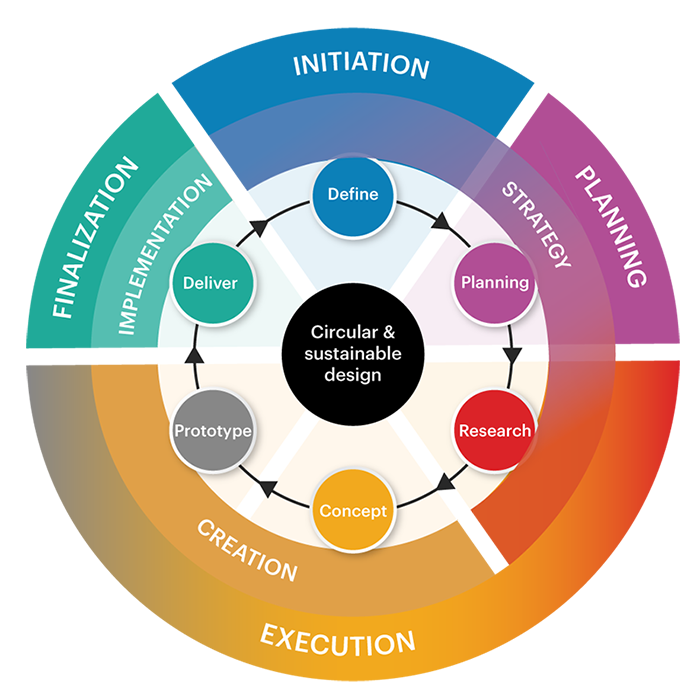Webpage

Design for Sustainability: How to Integrate Sustainability into the Product Development Process
Today, sustainability is one of the top priorities for technology companies as people worldwide become more aware of how our consumption affects the planet. The need for sustainable solutions is growing, and that's where Design for Sustainability (DfS) comes in. DfS focuses on reducing products' impact on the environment – something that is absolutely essential for the tech industry. According to the Ellen MacArthur Foundation, 80% of a product's environmental impact is identified during the design phase. This fact highlights the importance of making sustainability a core aspect of design best practices. While DfS can be incorporated at any stage of the product development process, it is most effective when considered from the beginning.
As per the 2021 UN Global Compact survey, sustainability-integrated companies outperformed peers by 21% in profitability and positive sustainability outcomes. DfS helps reduce the environmental impact of products in several ways, including:
1. Using sustainable materials: DfS enables businesses to actively choose and integrate sustainable materials throughout their product development procedures. By using materials that have a minimal environmental impact, such as recycled or sustainably sourced alternatives, businesses can contribute to a sustainable supply chain and reduce the depletion of resources.
2. Designing for efficiency: DfS enables businesses to optimize resource utilization by embracing innovative design strategies. Through thoughtful design choices, such as streamlining manufacturing processes, reducing energy requirements, and promoting resource-efficient usage patterns, products can achieve higher levels of efficiency throughout their lifecycle.
3. Designing for durability: DfS encourages businesses to prioritize durability in product design, resulting in longer-lasting and robust products. By emphasizing quality craftsmanship, resilient materials, and appropriate maintenance guidelines, businesses can reduce the frequency of replacements and extend the product's lifespan, ultimately reducing the environmental impact of manufacturing and disposal.
4. Designing for recyclability: DfS prompts businesses to incorporate recyclability considerations into product design. By implementing design features like modular components, easily separable materials, and clear labeling for recycling instructions, companies can facilitate the recycling process and divert valuable resources away from landfills or incineration facilities.
5. Promoting a circular economy: DfS fosters a transition towards a circular economy model, wherein products are created to minimize waste and maximize resource recovery. By adopting strategies such as product take-back programs, material regeneration initiatives, and remanufacturing practices, businesses can actively contribute to closing the resource loop and reducing the environmental burden associated with production and disposal.
How to Integrate Sustainability into the Product Development Process
There are various ways to integrate sustainability into the product development process. Some of the most important steps include:
1. Define Sustainability Goals: To embark on a journey towards sustainable software development, starting with clear and measurable sustainability goals is essential. Collaborate with stakeholders, including developers, project managers, and environmental experts, to define objectives that align with the organization's values and broader environmental responsibilities.
2. Apply Agile and Lean Methods: Agile and lean methodologies promote sustainability throughout the software development lifecycle. These approaches emphasize iterative development, continuous feedback, and waste reduction. By fostering a culture of adaptability and efficiency, teams can respond promptly to changes, optimize resource usage, and minimize environmental impact.
3. Choose Appropriate Technologies: Selecting the right technologies is critical in sustainable software development. Opt for energy-efficient hardware, cloud solutions with green credentials, and programming languages that prioritize resource optimization. Leverage AI to analyze and predict energy consumption patterns, aiding in selecting technologies that align with sustainability objectives.
4. Implement Green Coding Practices: Green coding practices involve writing code that meets functional requirements and minimizes resource consumption and energy usage. Consider the following strategies:
- Optimize Code Efficiency: Design clean and efficient code to reduce processing time and energy consumption.
- Minimize Server Requests: Implement strategies to minimize the number of server requests, reducing data transfer and energy usage.
- Energy-Aware Algorithms: Develop algorithms that consider energy efficiency as a factor, optimizing computational processes.
- Automated Code Reviews: Utilize AI-powered tools for automated code reviews that can identify and suggest improvements for energy-inefficient code snippets.
Benefits of Design for Sustainability
Integrating sustainability into the product development process offers several benefits for businesses. Let's explore five key advantages:
1. Enhanced brand reputation and customer loyalty: Integrating sustainability into product design enhances brand reputation and fosters customer loyalty. Sustainable products create a sense of purpose, increasing loyalty and positive word-of-mouth recommendations. By prioritizing sustainability, businesses differentiate themselves and attract environmentally conscious customers. This loyal customer base contributes to the long-term sustainability of the company.
2. Increased market opportunities: Designing sustainable products creates opportunities in a growing market. Businesses can reach a broader customer base by appealing to environmentally conscious consumers. Accessing new market segments and forging collaborations drive business growth and expansion. Sustainability integration aligns with the goals of companies and organizations, leading to potential partnerships and contracts.
3. Cost savings and operational efficiency: Sustainable design practices offer long-term cost savings by reducing energy consumption and operating expenses. Thanks to economies of scale, sustainable materials can reduce costs over time. Designing for durability reduces warranty claims and product returns, saving businesses money. Optimizing resource utilization and minimizing waste aligns with sustainable practices while benefiting the bottom line.
4. Regulatory compliance and risk mitigation: Integrating sustainability into product development ensures compliance with environmental regulations, providing a competitive advantage. Sustainable practices mitigate risks related to climate change and resource scarcity, enhancing resilience. Adapting to ecological conditions safeguards long-term business viability and prepares for future regulations and market shifts.
5. Innovation and competitive advantage: Integrating sustainability into product development fosters innovation and a competitive edge. It inspires creative problem-solving and drives the development of innovative solutions. Sustainable products differentiate brands and attract eco-conscious consumers, providing a competitive advantage. Staying ahead of sustainability trends positions businesses as industry leaders, capturing market share.
Conclusion
DfS offers technology companies a tangible path to transform their products into sustainable powerhouses. These companies can carve a more responsible and eco-conscious path forward by adopting sustainable materials, optimizing designs for efficiency, and championing a circular economy. This approach offers enhanced brand reputation, increased market opportunities, and cost savings. Prioritizing sustainability contributes to a sustainable future while ensuring business success.
Intelliswift's dedicated team of experts combines their digital product engineering prowess with a deep understanding of sustainable design, ensuring businesses can seamlessly integrate eco-friendly practices into their product development processes. Get in touch with us for further information on how we can assist you in fostering sustainable innovation and delivering outstanding products.




